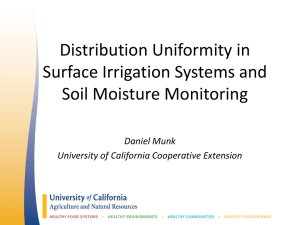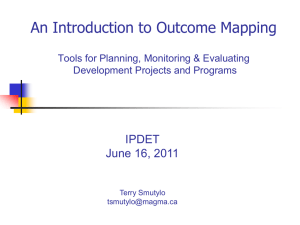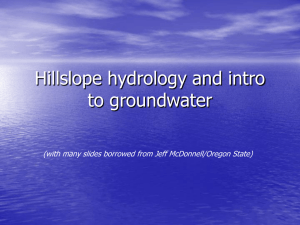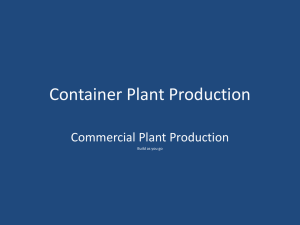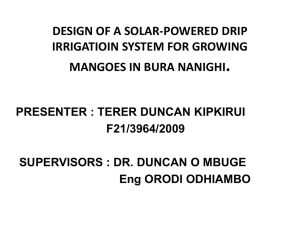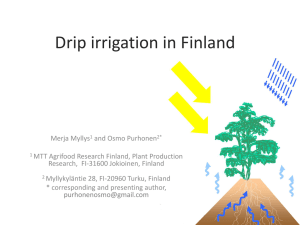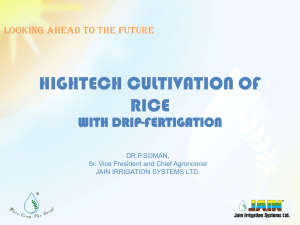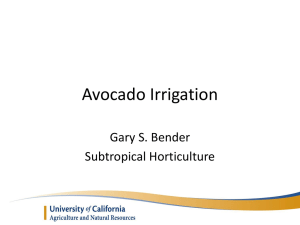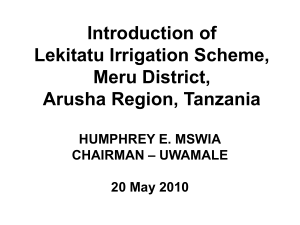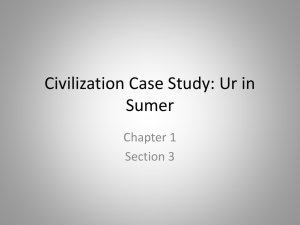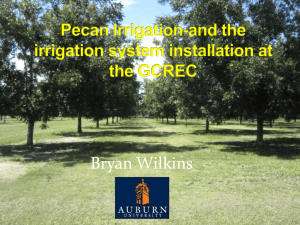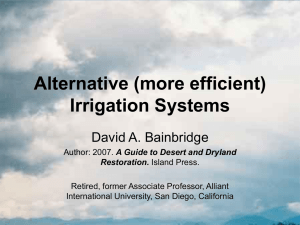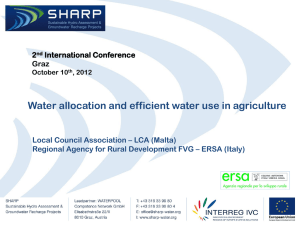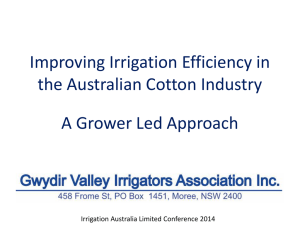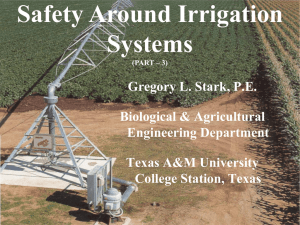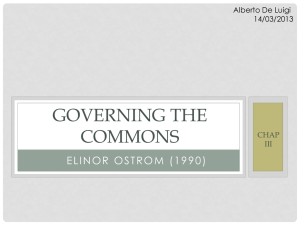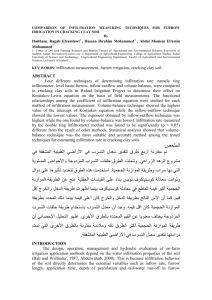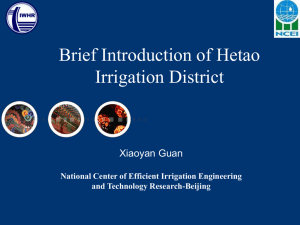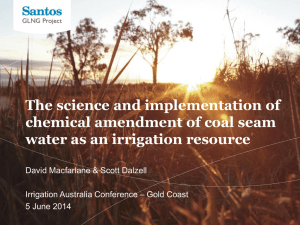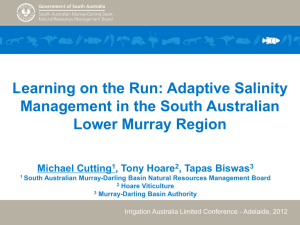Presentation - Irrigation Australia
advertisement
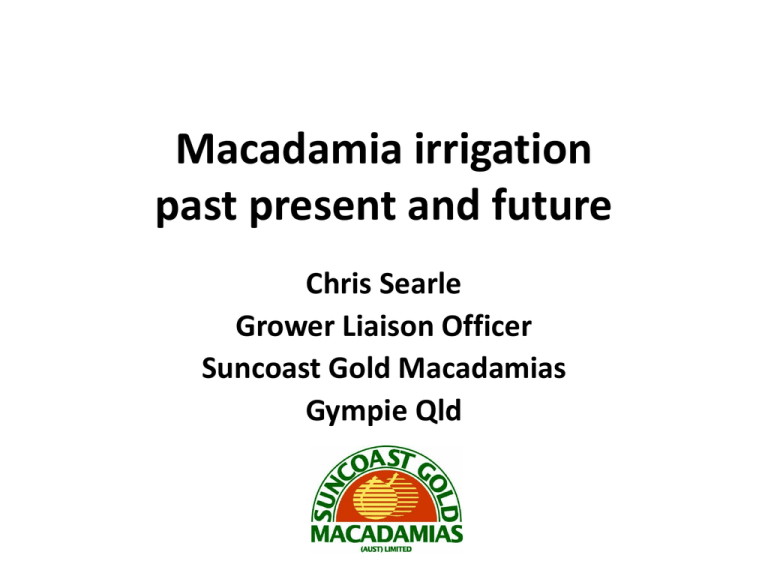
Macadamia irrigation past present and future Chris Searle Grower Liaison Officer Suncoast Gold Macadamias Gympie Qld Background • Macadamias one the few Australian plants brought into cultivation • Native to coastal rainforests of SE Qld- NNSW • Warm wet summers, cool winters, dry springs • Have a range of drought adapted traits surface roots + sinker roots - low resistance • Industry only started in Australia in mid 1960s • Cultivars are almost wild – little plant breeding Industry • Majority of production from NNSW/SE Qld • Largely rainfed - increasing use of supplemental irrigation in SE Qld • Major expansion in Bundaberg/central Qld since 1990s – irrigation is essential • Over 6,000 ha of irrigated production in Qld • Central Queensland where future expansion is likely to occur – all will require irrigation • Irrigation second biggest cost of production Knowledge • Limited information on water requirements of macadamia • Most sensitive periods to water stress 1. Oil accumulation (December/Jan) 2. Flowering – September 3. Nut set – October/November • Difficult to measure water stress in macadamia • Some varieties require more than others D aily w ater u se (L /tree/d ay) 65 60 H A ES 741 55 H A ES 344 50 45 40 35 30 m ax m in 25 20 15 J A S O N D J F M A M J T im e Fig.1 Range in daily transpiration (water use in L/tree/day) for two cultivars 741 and 344, averaged over two seasons (1999/2000 and 2000/2001), growing at Bundaberg under well watered conditions. Water use measured using Grainier sap flow. Trees 6m in height, 312 trees/ha. Actual water application • Grown successfully on 4ML/ha irrigation in Bundaberg (around 1,000mm/yr rainfall) • 8-10 ML at Emerald one line of drip tube (around 640mm rainfall) • Supplemental irrigation of 1.4ML/ha at Amamoor, SE Qld (around 1100mm rain/yr) significant impact on yield. • Little use of monitoring equipment – though use is increasing - mainly capacitance probes Sprinkler V Drip continuing debate Sprinklers • • • • • • • More expensive to install More expensive to maintain Easier to apply Allows use of solid fertliser Less efficient water use Easier to monitor Allows for breakdown of organic matter (mulch, compost, manures) • Wets nuts during harvest period (possibly detrimental) Drip • Cheaper to install – except higher filtration costs • Cheaper to maintain/run • Need to think ahead • Mostly fertigation • More efficient water use • Where do you place soil water monitoring equipment ? • Does not assist with organic matter breakdown • Nuts remain dry during harvest period ‘Others factors’ • Need to consider other factors besides water requirements of tree when designing a mac system • Maintenance of inter-row ground covers • Bare earth to facilitate harvesting creates problems • Long term soil degradation (no organic matter) • Reduced infiltration rates • Sprinklers allow for organic matter breakdown • Use of manures as fertiliser (cheap alternative) • Unlike avocados no major disease problems created by irrigation – still needs to be considered • Supplemental irrigation – maintenance of tree health Long term decline in ‘soil health’ Under-tree infiltration rate 4.8mm/hr Grassed inter-row Infiltration rate 29mm/hr Current systems • Many older systems designed in 90s have problems - uneven pressures – ageing systems • GPS planting from 2005 better contour mapping – better systems? • Around 10% of plantings since 2004 on drip • Economics forcing macadamias onto more marginal soils – use of drip tube • Irrigation seen by many as a ‘chore ‘ rather than a vital component of their business • Need better systems tailored to coastal soils and rainfall patterns – better monitoring Future system Sub-surface drip in macadamia • First of its kind • System designed around soil type and cultivar • Concerns about long term viability • Root intrusion- clamping off – aggressive roots Potential benefits • Ability to harvest while irrigating • Keep under-tree ground covers growing • WU efficient – labour efficient Soils map information Infiltration rate >120mm/hr Infiltration rate <5mm/hr Need to define soils boundaries due to large differences in infiltration rate Defined soil boundaries by sampling on 50m grid Low infiltration rate <5mm/hr High infiltration rate >120mm/hr Matched cultivars to soil type The system • Pressurized system - self flushing • Use of highly accurate satellite guidance • Initially two lines drip tube (2.3l/hr at 40cm spacing - 1.28mm/hr) • Four lines when tree mature (2.58mm/hr) • Open field hydroponics • Rest of development 90l hr sprinklers (2.86mm/hr) • Several pumps - manifold Sub-surface drip low infiltration rate Gully 90 l hr sprinklers High infiltration rate The future of irrigation in Macs • Macadamia industry likely to expand - all irrigated • Expansion onto more marginal soils • Systems tailored to coastal soils and rainfall patterns – better monitoring • Need for system designers to work more closely with agronomists, soils scientists, growers • Awareness of factors other than just water requirements of crop

